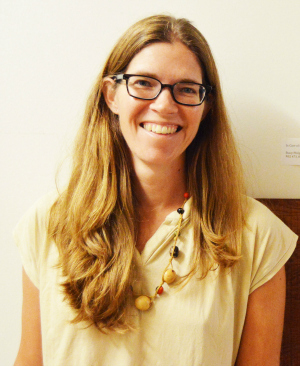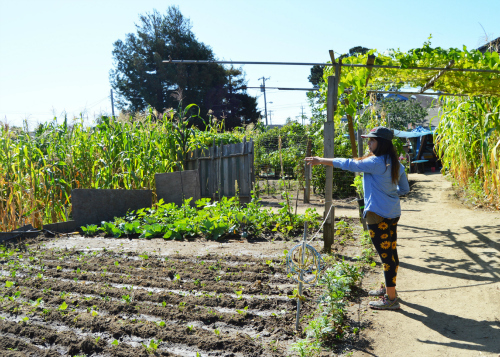Campus News
Bugs in an urban jungle: What green spaces mean for ecology and community
Since 2013, UC Santa Cruz environmental studies professor Stacy Philpott has studied insect biodiversity in urban gardens to better understand the ecological role these green spaces provide.


Since 2013, UC Santa Cruz environmental studies professor Stacy Philpott has studied insect biodiversity in urban gardens to better understand the ecological role these green spaces provide. Her research has taken her to 18 gardens across central California.
From Watsonville to Salinas, San Jose, and Santa Cruz, Philpott discovered that each urban garden is different with cultural and economic factors influencing its biodiversity.
This is reflected in the Beach Flats Community Garden near the Boardwalk in Santa Cruz. Only half an acre, it is the only green space in the area, a lush oasis tucked behind urban grit.
It is in an area with a troubled past, known for a higher than average crime rate, dense urbanization and poverty. But for more than 20 years, the garden has helped build community in the area and is now under threat of being closed next month.
“It seems more than other gardens to be a community space. We often see folks shelling beans together, or playing games, or just having weekend conversations – more so than many of the other community gardens where we are working,” Philpott said.
Research findings discussed
Philpott, holder of the Ruth and Alfred Heller Chair in Agroecology and the interim director of the Center for Agroecology and Sustainable Food Systems (CASFS), will discuss her research in the Beach Flats Community Garden and other urban gardens when the Division of Social Sciences holds its annual Research Frontiers Evening Nov. 5, 2015 at the Santa Cruz Museum of Art and History. Learn more.
“It is a refuge here,” said undergraduate student researcher Montse Plascencia (Stevenson, ‘15, environmental studies and ecology & evolutionary biology).
But the residents also share the garden with something else. “It is a safe spot for people and also bugs,” Plascencia said
Like many of the urban gardens Philpott and her team study, the Beach Flats Community Garden plays a significant role in the diversification of both insects and a community. It provides an ecosystem for at least 12 species of bees, nine species of ladybugs, seven species of ground spiders, and four superfamilies of parasitoids.
“Just this week when we sampled there I found six species of ladybugs,” said Monica Egerer, a Ph.D. student and researcher on the project. “In other gardens, however, I find on average just one or two species of ladybugs in a sampling. For many this may be counterintuitive, but I think it reflects that the garden is obviously an urban oasis for biodiversity,” she said.
“It is really important for maintaining biodiversity and movement of organisms from one location to another,” Philpott said.
Effects of culture on ecology
Philpott and her team also notice cultural factors that contribute to a garden’s ecological diversity and environment. What people grow impacts the types of bugs, birds, and bees in a garden’s habitat. And what people are likely to grow depends on their cultural background and ethnic heritage.
For example, 46 percent of the Beach Flats residents are Latino (compared with the citywide average of 17 percent.) The garden features food reflective of a Latino cuisine–beans, squash, and corn as well as popular condiments like cilantro and cactus. Some of the team’s data show that the crops and varieties grown in Beach Flats differ significantly from those in other nearby gardens.
In comparison, another urban garden Philpott studies is in an Iranian-populated neighborhood of San Jose where common cultural foods like cucumbers and mint are grown. These cultural and ethnic differences in what people decide to plant likely enhances overall biodiversity in the region, as different crop species likely attract different types of bugs and birds, Philpott said.
There are many other variables that contribute to a green spaces’ diversity as well. Philpott considers factors such as as how wooded an area is, what the shrubbery is like, whether the beds are mulched to study what impacts ecological and environmental habitat.
Community learning and research
“I get inspired by these gardens.” Plascencia said about the role in science education these spaces provide. When Plascencia graduates, she hopes to find an active educational role in urban gardens in Los Angeles where she is from.
Julia Burks (Kresge, ‘16, environmental studies), another research assistant on the project, said she always sees members from the community in the garden relaxing and socializing as they work.
“Residents come here for emotional well being and to get involved in their community,” she said.
Egerer adds, “I think that we as a society need to put more value on these places, both for their obvious community and cultural significance as well as for their ecological importance for ‘bugs’ in an urban jungle.”